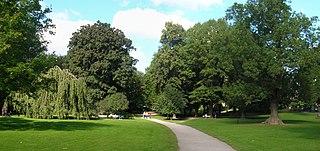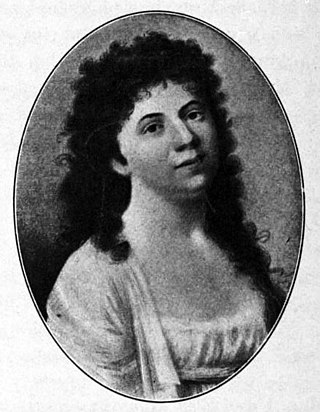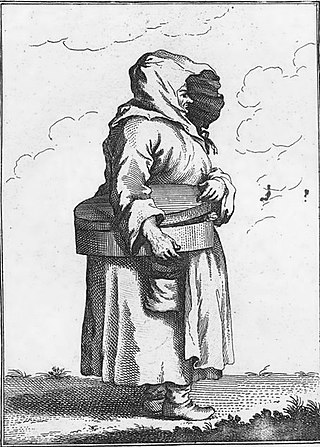Related Research Articles

Elisabeth Olin née Lillström was a Swedish opera singer and a music composer. She performed the leading female role in the inauguration performance of the Royal Swedish Opera in 1773, and is referred to as the first Swedish opera prima donna. She was the first female to be made Hovsångerska (1773), and the first woman to become a member of the Royal Swedish Academy of Music (1782).

Marie Louise Marcadet née Baptiste was a Swedish opera singer and a dramatic stage actress of French origin. She was active in the Royal Swedish Opera as a singer, and in the Royal Dramatic Theatre and the French Theater of Gustav III as an actress. She was a member of the Royal Swedish Academy of Music from 1795.
Caroline Lisette Stenberg was a Swedish stage actress, singer and pianist. She was a popular stage celebrity artist in Gustavian era Stockholm, and a star of the Stenborg Theatre. She was not only an actor but also a singer and a musician, and played piano forte between the acts.
The Stenborg theatre, also called Svenska Komiska Teatern, Komiska Teatern and Munkbroteatern, was a historical Swedish 18th century theatre, active between 1784 and 1799 in Gamla stan in Stockholm. It was the second theatre of Stockholm during the Gustavian age. In 1784-87, before the inauguration of the theatre of Ristell in Bollhuset, it was the only dramatic theatre of the native language in Stockholm.
Johanna Catharina Löfblad née Embeck or Enbäck, also known as Madame Gentschein and Madame Löfblad, was a Swedish stage actress. She was a member of the pioneer group of actors in the first Swedish national theatre of Bollhuset.

The Stenborg Company was a Swedish Theatre Company, active in Sweden and Finland in the 18th century. It was also called Stenborgska skådebanorna, Svenska komeditruppen and Svenska Comedien ('Swedish Comedy') or Svenska Teatern. It is one of the most famous theatre troupes in its country's history. In the period of 1754–73, between the closure of the first national Swedish theatre in Bollhuset and the foundation of the next, The Royal Swedish Opera and the Royal Dramatic Theatre, it was the only Theatre performing in the native language in Stockholm. It also has an importance for the history of Finland, being the first professional secular theatre troupe in this country. It was a traveling troupe in 1756–80 and then housed in several buildings.

Carl Stenborg was a Swedish opera singer, composer and theatre director. He belonged to the pioneer generation of the Royal Swedish Opera and was regarded as one of the leading opera singers of the Gustavian era. He was a hovsångare and a member of the Royal Swedish Academy of Music.
Hedvig Christina Wigert née Falk was a Swedish opera singer. She belonged to the pioneer generation of performers of the Royal Swedish Opera.
Martin Nürenbach or Nurembach was a German acrobat, stage actor, dancer and equilibrist active in Sweden, Norway and Finland. He was a pioneer in Norwegian theater history by founding the first public theater in Oslo in the year 1771.
Karl Gustav Bonuvier, was a Swedish stage actor and theatre director, active in Sweden and Finland. He is remembered for having founded the first theatre house in Finland.

Ulrika Eleonora Säfström was a Swedish stage actress, described as a great dramatic star of Stockholm in her day. She was used for heroine parts and was also popular in operettas.
Maria Katarina Öhrn or Maria Katarina Berlin was a Swedish stage actress and singer. She was active at the Stenborg Troupe in Humlegårdsteatern from 1776–80 and in Eriksbergsteatern in 1780–83. During her career, she was one of the most popular stars on the Swedish stage as the female star of the Stenborg theatre, at that time the leading dramatic stage, prior to the founding of the Royal Dramatic Theatre.
"Ebba" Jeanette Morman was a Swedish stage actress. She was active at the Royal Dramatic Theatre in 1791-1802 and was popular actress, known for her demonic character portraits.
Margareta Sofia Lagerqvist was a noted Swedish opera singer and stage actress.
Helena Spinacuta, was a Swedish stage actress and acrobat and tightrope artist. She was married to the famous Italian (Venetian) acrobat Antonio Bartolomeo Spinacuta.
Antonio Bartolomeo Spinacuta was an Italian (Venetian) tightrope walker, acrobat, singer, and dancer. He is often referred to as Spinacuta. He was married to the Swedish actress Helena Pettersson. He toured Sweden in 1784–1787, where he had a remarkable success and aroused considerable fame. In 1786, he released the first hot air balloons in Sweden. In 1795, he was noted to be active at the Ricketts company circus in Philadelphia in US.

Bakelse-Jeanna (1702–1788), was a Swedish pastry-seller, the name signifying "Pastry-Jeanna". She was a well known and distinctive character in Stockholm at that time, and often used as a figure within Swedish plays, songs and literature during the 18th and 19th centuries.

Events from the year 1785 in Sweden
Christina Nyman known as Madam Nyman (1719–1795) was a Swedish brewer. She was a major figure in contemporary Stockholm business life and known as a benefactor of culture. She is perhaps most known for establishing the Stenborg Theatre in partnership with Carl Stenborg (1784). She, as well as her brothers and nephews, belonged to the political allies of king Gustav III of Sweden among the merchant class, and he reportedly treated her as a valuable partner.
Jean (Johan) Löfblad (1728-1774), was a Swedish stage actor. He was a member of the Stenborg Company, for a long period the only Swedish language theater active in Stockholm, and described as the leading star and attraction of the company together with his wife Johanna Löfblad. He was foremost famed for his role as Harlequin, a very popular genre, and referred to as the "Harlequin of Stockholm".
References
- ↑ Lindström, Crister. "Christina Margaretha Rahm". Svenskt kvinnobiografiskt lexikon. Retrieved 12 December 2022.
- ↑ Johan Flodmark: Stenborgska skådebanorna: bidrag till Stockholms teaterhistoria, Norstedt, Stockholm, 1893 (in Swedish)
- En lång teaterkarriär , Släkhistoriskt Forum, 2004 (in Swedish)
- Johan Flodmark: Stenborgska skådebanorna: bidrag till Stockholms teaterhistoria, Norstedt, Stockholm, 1893 (in Swedish)